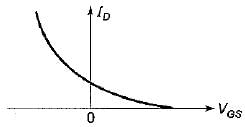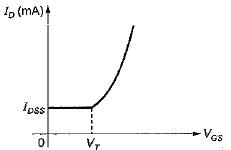Test: Field Effect Transistors- 2 - Electrical Engineering (EE) MCQ
15 Questions MCQ Test - Test: Field Effect Transistors- 2
In the saturation region, the JFET transfer characteristics are
The threshold voltage (VT) of a - MOSFET is defined as
In a JFET, the drain current magnitude decreases as the reverse bias across the gate-channel increases because a larger reverse bias causes
Assertion (A): In the JFET, the transverse electric field across the reverse biased p-n junction controls the conductivity of the channel.
Reason (R): In enhancement and depletion types of MOSFET, the transverse electric field induced across an insulating layer deposited on the semiconductor material controls the conductivity of the channel.
Four important parameters of MOSFET and JFET have comparatively larger or smaller values. In comparison to a JFET, a MOSFET will have which one of the following combinations?
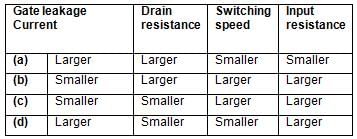
Match List-I (Device) with List-II (Applications) and select the correct answer using the codes given below the Lists:
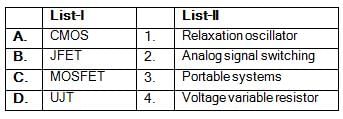
Codes:
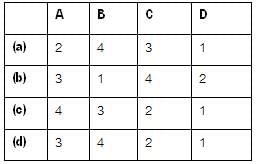
Consider the following statements:
1. In enhancement n-channel MOSFET an induced n-type channel can be produced between the source and drain if VGS is negative.
2. AFET is more sensitive to variations in input voltage in comparison to an ordinary transistor.
3. AFET is characterized by transconductance.
4 UJT has onli one p-n junction and three leads.
Of these statements which are not correct is/are?
What are the values of VP and ID for VGS = 0.5 V of an N-channel FET that has IDSS = 10 mA with drain voltage of 5 V and gmo = 5 mA/V?
An N-channel JFET has IDss = 1mA and VP = -5 V. The value of its maximum transconductance is
N-channel FETs are superior to P-channel FETs, because
In a FET as VGS is changed from zero to increasing reverse bias, the value of gm
A FET is a better chopper than a BJT because it has
The variation of drain current with gate-to-source voltage (ID- VGS) characteristic of MOSFET is shown in the figure below.
The MOSFET is
